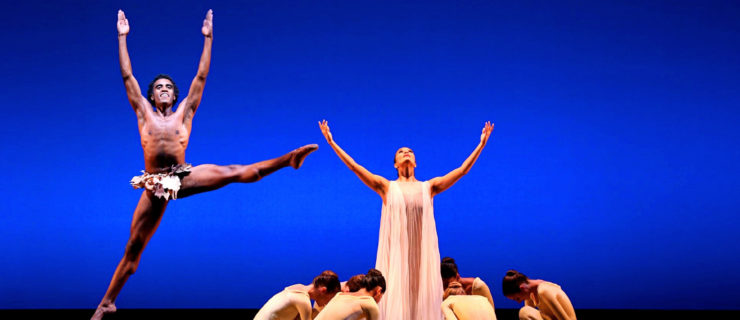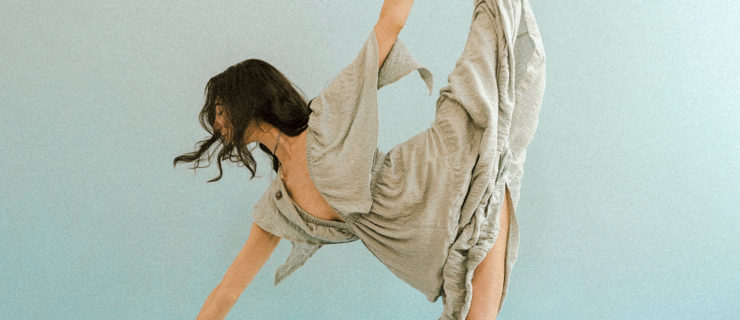Mind Over Mirror: Staying Positive About Your Body
When was the last time you stood in front of the mirror and thought positively about your reflection? After hours in the studio trying to perfect every aspect of your technique, it’s easy to develop a love-hate (or even a hate-hate) relationship with your body. “Dancers’ bodies are central to their art and technique,” says Shantel Ehrenberg, professor of dance at University of California, Irvine. “If dancers don’t have a healthy relationship with their body and yet have to deal with it everyday, it will be more difficult to advance technique and pursue dance in a way that benefits the whole dancer—body and mind.” Here, we’ve compiled 10 strategies for maintaining a positive body image that will help you love the skin you’re in.
1. Feel your dancing.
As a dancer, you have kinesthetic awareness. This means that without looking at the mirror, you can sense the alignment of your body. Continuing to develop this awareness will help you to trust your body, to feel more confident in your dancing and to spend less time staring at yourself. To hone in on your kinesthetic sense, picture your body executing a specific movement and then watch in the mirror to determine how closely it matches what you imagined. Repeat until your mental image becomes accurate.
2. Self-correct; don’t self-deprecate.
If you find yourself looking at the appearance of specific body parts, you may be sabotaging yourself. “In my experience, dancers who don’t like the shape of their legs, for example, look in the mirror to self-correct, but only manage to see short legs or big thighs,” says Lucinda Sharp, a psychologist at The Australian Ballet School in Southbank, Victoria. “This use of the mirror is a waste of your class time, doesn’t assist technical or artistic progress, doesn’t make you feel good about your body and lessens your enjoyment of dance.”
3. Choose a focus.
A technique class or a rehearsal means hard work punctuated by a slew of critiques. Even if you arrived with a positive attitude, it can be easy to get bogged down when you receive a lot of corrections in a row. “Often, dancers want to please their instructors and find it difficult to know which correction to focus on and what is best for them,” explains Ehrenberg. Pick one correction to work on in your next class. When you look in the mirror, instead of scanning for a variety of details, you can check for one specific goal. Change your inner dialogue from “Oh, no! I’m not turned out, my shoulders are tense and my jetés are sloppy” to “Am I gripping my quad in this développé?” Ehrenberg explains that this mindset will help dancers “do as much as they can for that class and that day, and be proud of whatever [they] accomplish.
4. Set realistic goals.
Scenario: You’re doing a new adagio full-out for the first time, and when you look in the mirror, you’re irritated by your less-than-perfect execution. Next time you get frustrated by a new step, think about a movement that you feel confident doing, and remember that at one time it, too, was new and difficult. Don’t expect to look in the mirror and see perfection. Instead, acknowledge the things that you can do well and resolve to work harder at the things that challenge you.
5. Don’t engage in body-bashing.
Dressing rooms are often abuzz with conversation before and after class. Some dancers, instead of discussing Orlando Bloom’s latest movie or The Decemberist’s awesome new album, stand in front of mirrors and talk about their bodies, what they eat and how much weight they want to lose. Sharp says that if this scenario sounds familiar, “keep out of conversations about food, dieting and body weight, or change the subject to something more interesting and more positive.”
6. Speak up.
“If you feel negativity is coming from peers, it’s important to let the teacher know,” says Sharp. Your instructor may not be aware of the conversations that take place in the dressing room, and he or she can tell your classmates to refrain from discussing these matters. Talk to your teacher about putting a moratorium on body and diet topics for a specific period. “Students may be amazed at how much time they actually spend talking about food and [being encouraged to stop could] help them realize that it’s much more fun to talk about other things,” Sharp says.
7. Stop comparing.
Watching your classmates is a great way to learn and pick up on what others do well. However, if you spend time disparaging yourself because your grand battement isn’t as high as your neighbor’s, then you’re taking time away from yourself. Take a cue from the old saying, “If you can’t say something nice, don’t say anything at all.” If you can’t look around for constructive purposes, don’t look around.
8. Banish the mirror.
When dancers look in the mirror, their thoughts and feelings can affect the way they see and respond to their reflections. For this reason, “the mirror is not an accurate reproduction of the body,” says Ehrenberg, whose research combines psychology and dance. Ask your instructor if the class can try a few exercises facing away from the mirror. You may feel disoriented at first, but if you practice continuously without a mirror, you’ll not only develop a precise inner awareness of your movements, but also feel more confident when you perform. After all, there’s no mirror onstage.
9. Dress for success.
Does the following situation ever happen to you? Because you were running late to class, you grabbed your least favorite leotard and a pair of tights with a huge rip on the upper thigh. Now, instead of focusing on your switch leaps and pencil turns, all you think about when you look in the mirror is how you hate the way you look in this outfit. This is not a recipe for a productive and enjoyable class. You can’t avoid being late ever again—it happens to everyone—but you can make sure that your closet is only full of dance clothes that make you feel confident. Get rid of the purple leo that bunches in the waist or the neon green unitard that you feel obligated to wear because your sister picked it out.
10. Enjoy your body.
If all you do is eat, sleep and breathe dance, maybe it’s time to broaden your horizons. Once a week, celebrate your body outside the studio. Do something just for the fun of it and notice how strong your body is, whether in a demanding yoga class, riding a bike up a long hill or going for a strenuous hike. With no mirror to look at, you’ll see there’s no wrong way to enjoy being comfortable with yourself.
What’s your Image?
To see if you have a positive approach to your body, ask yourself the following questions:
1. Do I focus on how my body moves and the shapes it makes when I dance (or do I get distracted by thinking about what my body looks like)?
2. Do I enjoy the sensation of moving through space?
3. Do I immerse myself in the sensation of dancing?
4. Do I treat my body well by, for example, seeking the right treatment for injuries, getting massages for tight muscles, eating well or luxuriating in long warm baths?
5. Am I generally healthy?
6. Do I have the strength to get through a class and finish strongly in the allegro section?
If you can’t answer yes to all these questions, it may be time to talk to your parents, dance teachers and even a counselor about what you can do to improve your body image.
Quiz adapted from a body wellness inventory created by Australian Ballet School psychologist Lucinda Sharp.



